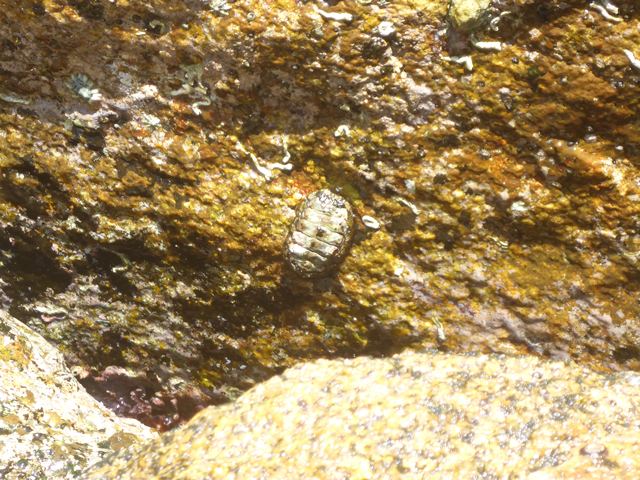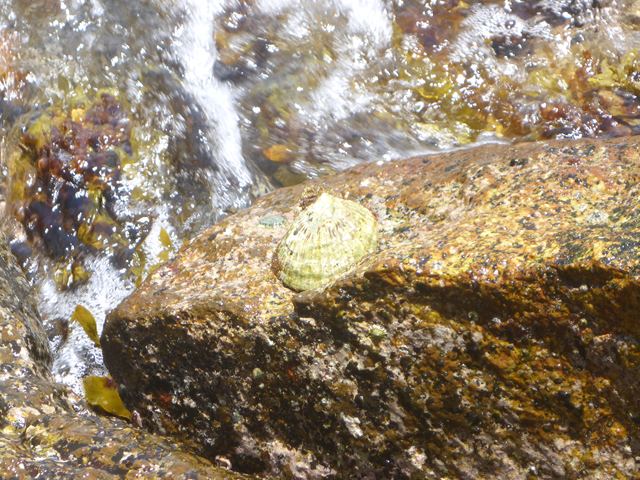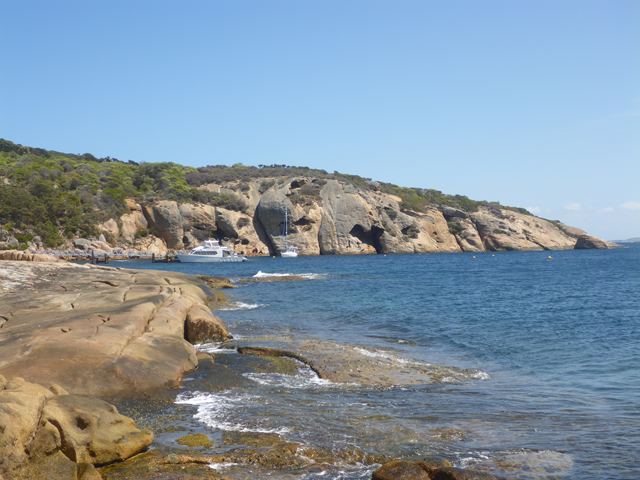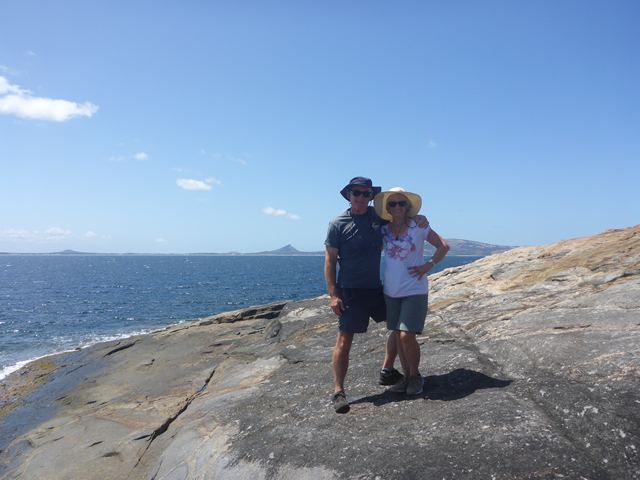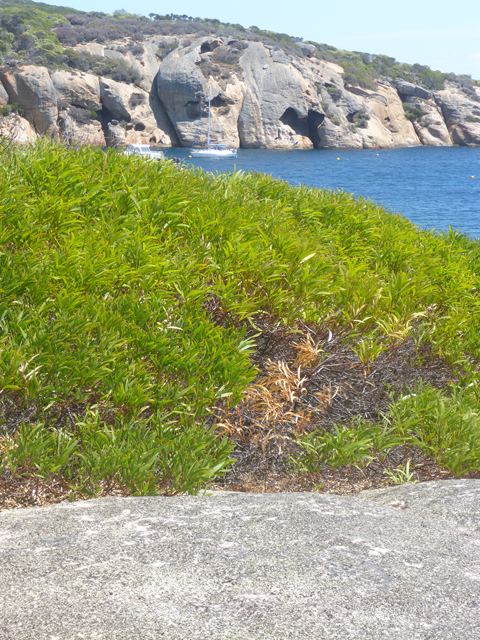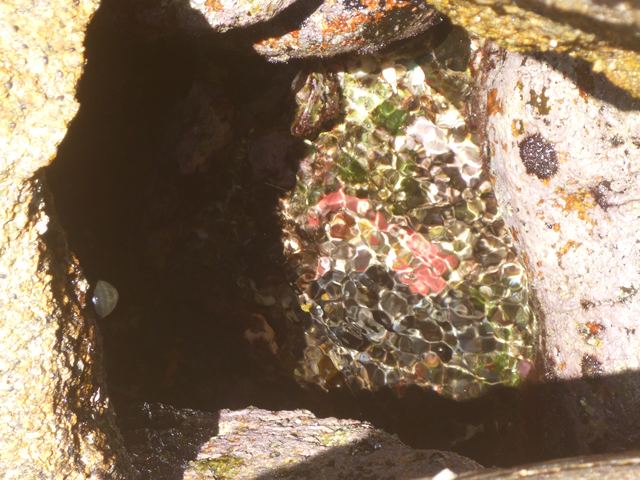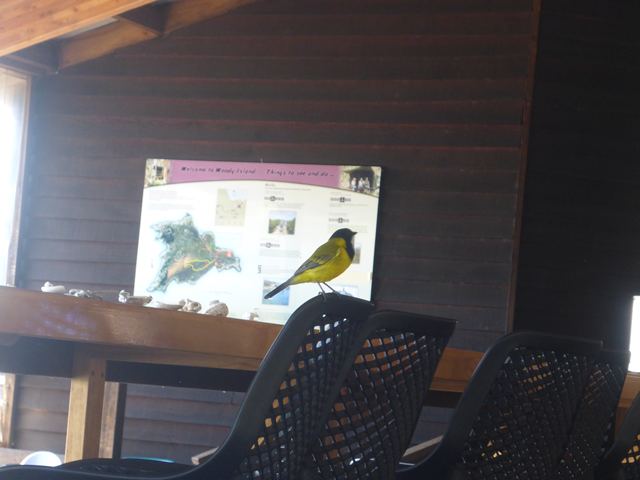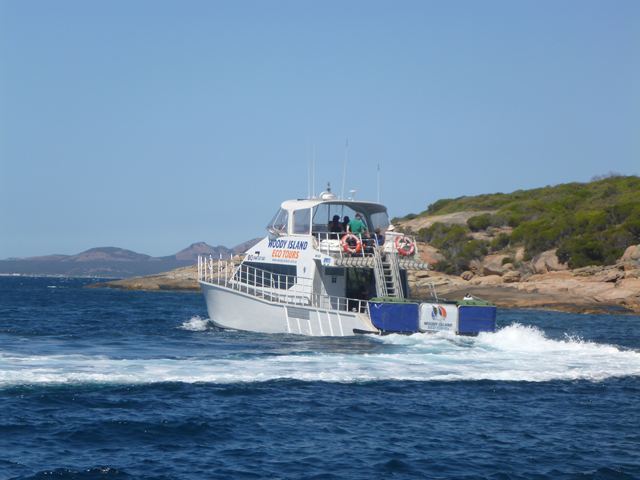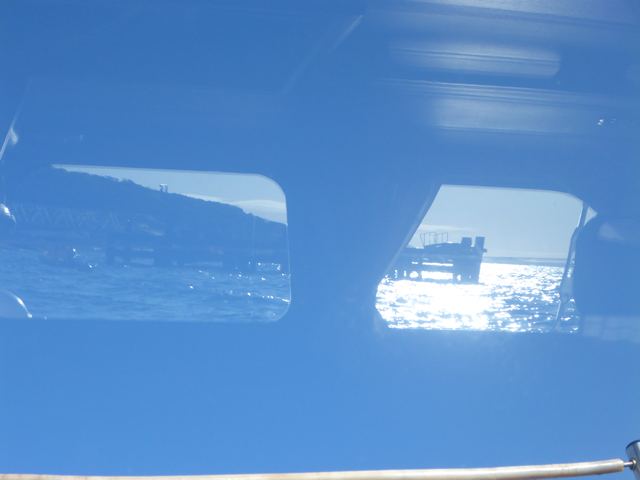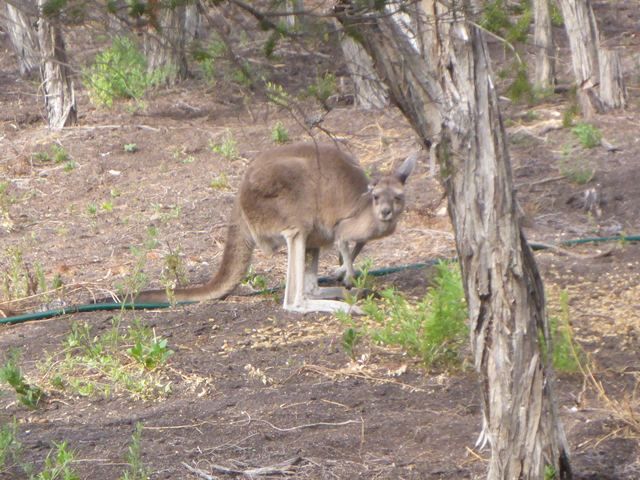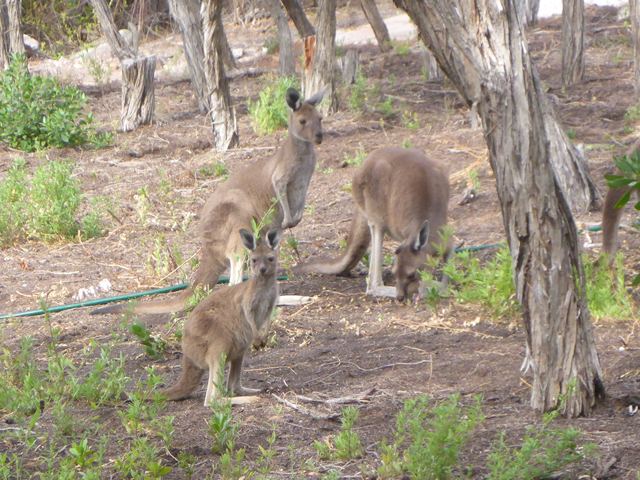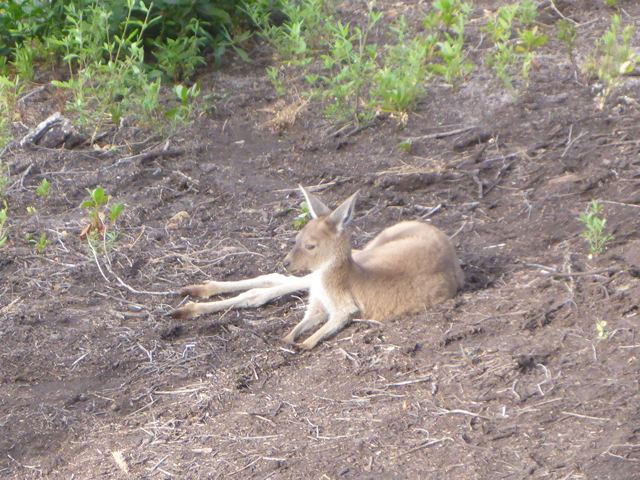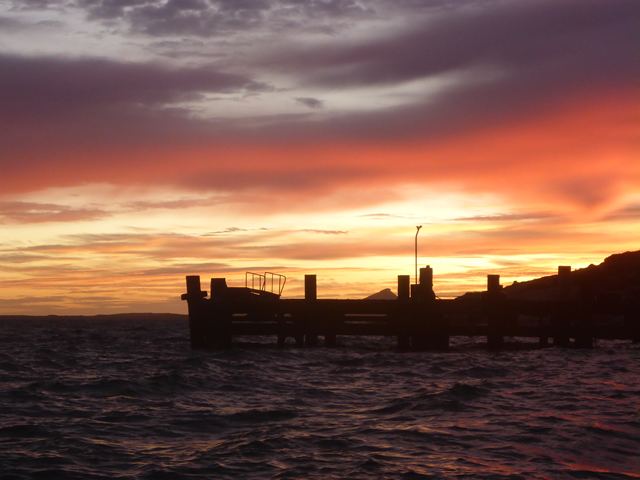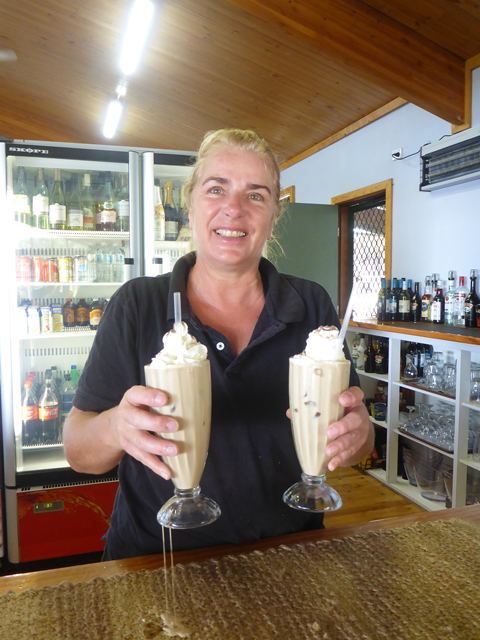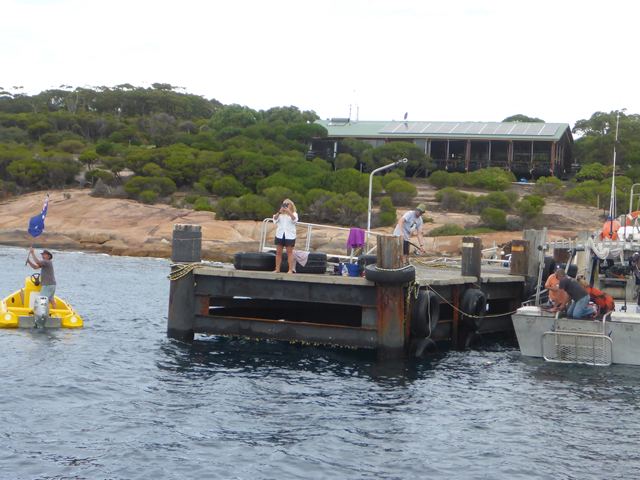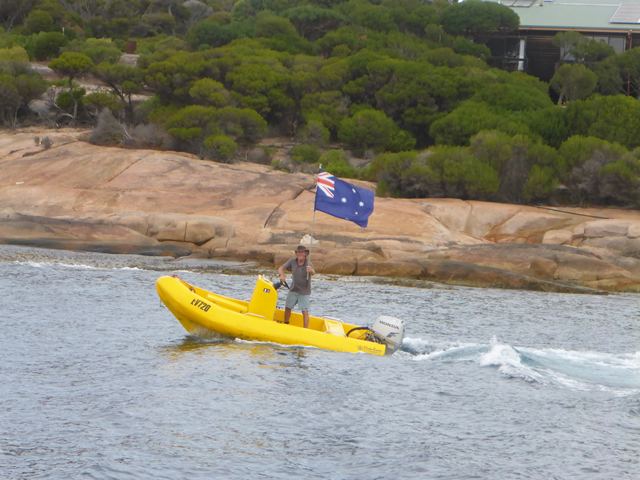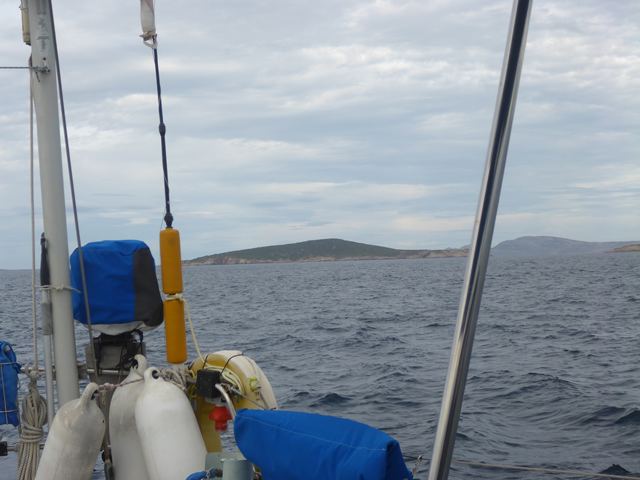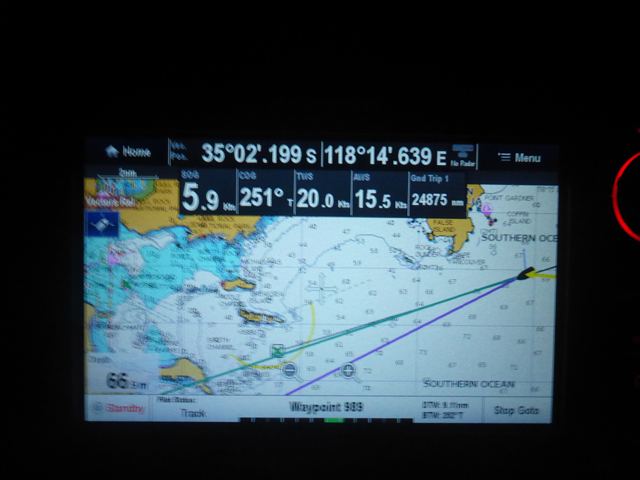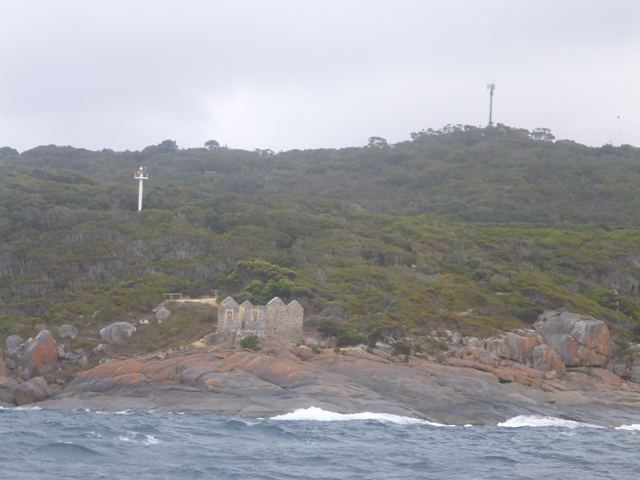2020 Aus Woody Giants and Hungry Kangaroos

|
Woody Giants and Hungry Kangaroos In our scramble over the smooth pink granite rocks that make up the Woody Island shoreline we found chitons and limpets that were at least four times the size of the ones we had seen before in Tonga and New Zealand and we wondered why this phenomenon did not apply to other island dwellers. Maybe the rock huggers grew to an older age and therefore bigger size. The area was full with colour and in the rock pools bright red algae stared back at us. I was peeping through the undergrowth with the hope of seeing some of the illusive kangaroos; thirty were brought to the island many years ago and on our previous walk we wondered what they ate. Rob spotted some scrapings in the path and wondered if they ate roots. He was right, that is one of their staples. There was a time, after the sheep were taken off, when they would have had access to grass and oats but the natural undergrowth has returned since the 2006 fire and the recent drought dried up lots of their fresh water puddles so they rely on a water supply and food at the lodge and Rudi and Frauke happily oblige with water, sheep nuts and oats. The older roos are so conservative and will not try the salad left overs that Rudi puts out, but the younger ones will give salad a try. Animals have to be adaptable in this environment. They come to the lodge after the daily visitors have left so we were hoping we might see them. Meanwhile back in the lodge the Fearless Bush Minstrel I had seen before in his own tree was paying a visit. Commonly called the Golden Whistler he hunted for crumbs before moving on. We sat with Rudi and Frauke and her son Michael, who was on a brief visit from Germany, and chatted over various things before returning to Zoonie for the roughest night yet. We were planning to leave the next day, the windows of favourable weather come and go very quickly here so as there is lots of cyclone activity going on up north which draws on wind from the south, as one source of fuel for their demanding engines, we decided to take advantage of the favourable 15 – 20 knot winds. Just this time the unpredictable movements of the current cyclone gave us our opportunity. The next morning Frauke told us how violent was Zoonie’s pitching that it worried her, but because we were sleeping in the saloon in the middle of Zoonie’s length we didn’t feel the extreme extent of her up and down movement and we slept well. We sat on one of the settees chatting to a lady from Perth who resumed her caravanning holidays three years after her husband’s death once she had worked through her grief and loss of confidence. The first thing she did was replace the big car and caravan with a much smaller version of each and now she takes herself and any friend who wants to join her off on long rambles north and south through western Australia. We admired her resolve, a traveller like us. Frauke’s iced coffees were delicious and overflowing! The sun moved across the island casting shadows over the area around the lodge and the kangaroos arrived, eight of them and we leaned over the banister to take photos and watch them, watching us and enjoying their supper. The biggest has a crumpled right ear and Rudi can get within a half metre of him while the youngest was the boldest with strangers, lying not far from us and paying only scant attention to our movements. We said our farewells to our new friends and headed back to the now very still Zoonie, the wind having dropped and veered leaving her in calm waters. I squeezed into my wetsuit and carrying our masks and flippers aft we were determined to explore underwater world in the now attractive sea just before leaving for good. The sea grass and weed was abundant and the submarine growth on the pink granite rock faces was a multitude of bright colours. The wreck Rudi told us about was there; a small wooden vessel well rotted so we could see the seabed through the missing hull timbers. We swam with thousands of clear jellyfish which had no visible tentacles and were not a problem. There was a variety of fish, many of them recognisable from previous dives but we did not find any sea dragons, I think that would have taken a longer dive to the other side of the jetty. By far the most interesting find on this trip was the sinker to our mooring; the railway wheel and ship chain. The wheel was now clearly visible and the heavy chain pulled away from it, while still attached, in a straight line. Frauke had done a comparison of our position with previous photos on her phone of other moored yachts on the same mooring and our findings confirmed the fact Zoonie had played her part in re-positioning her buoy. Rudi gave us a fantastic send off as you can see, a knight on his yellow mount with banner flying, and Frauke took photos from the pier but after only a few minutes we were in for a shock! Zoonie rounded the island and we had two waypoints to reach before we could set the course directly for Albany. I had filled in the log book before we departed and the barometer read 1013 mbs but when I checked it again after half an hour, almost in passing, it had dropped to 1010 mbs an alarming drop in such a short time. “Rob if that drop continues we will have to go back, 6 mbs in an hour is unthinkable.” “You must be kidding,” Rob said, disappointed. Fortunately the dark blue pointer stayed on 1010 for the duration of the passage; so what had caused the drop? 1) The weather was benign with a settled cloud state and calm water so that didn’t seem likely. The sky was grey but not threatening or particularly dark 2) our location behind the island? Well partly I think linked to 3) magnetism in the pink granite or 4) Flinders Bar; Matthew Flinders noted on his barometer on the good ship Investigator, the same barometer as used by Cook thirty years before, that the mercury rose when there was a change from a land to sea breeze to a sea to land breeze and vice versa there was a fall when the sea to land breeze changed to a land to sea breeze as one might expect as the temperature of the air over the land cools in the late afternoon. Apart from a cheeky 28 knot blast of wind between the islands as we left the conditions we had no more alarms until we arrived in King George Sound when the man overboard alarm sounded; a quick head count proved there was no action necessary. Frauke and Michael had been to a killer whale feed above some deep canyons (Bremer, Hood, Henry and Knob) wedged in to the continental shelf just off Bremer Bay. Like me the Orcas like to feed first thing in the morning and in the evening so our timing did not fit and we saw none. I wasn’t too sorry, admiring killer whales on their passage is one thing but watching them feed on giant squid and whales by rounding them up as they rise toward the surface on a cold water upwelling is another. The first photo on the chartplotter shows the waypoint just infront of Zoonie where the whales do their fishing. Some of the squid are 10 metres long. The next morning was overall grey and the wind was falling weak so we had to motor sail for a while. There were lots of shearwater fishing and relaxing on the water surface. Suddenly the chartplotter turned itself off. The gremlins were at work again. Just as well I had recently recorded our position and we have GPS backups aboard. It soon came back on again thank goodness. The wind was rising as we approached the Albany entrance as we knew it would; another short weather window was ending. As Rob changed our course on the chartplotter the man overboard alarm went off and a rummage for the manual told us to press the button for four seconds to cancel it. We also learned that the autopilot is disconnected if the alarm goes off so that rescue procedures can be instigated. Cool, learn something every day. Another yacht was anchored in the shelter of a bay to our left as we motored around the ship wharf towards the marina. We wondered how he was managing on what was likely to be a reedy bottom. We found out later. The Western Australian Government’s Department of Transport owns and runs these marinas and they had allocated us a nice easy pen to enter so all should have been straightforward, but the wind caught Zoonie and at the same moment the bow thruster decided to take a break, literally the fuse blew, so Zoonie drifted very gently across to rest on the big motor cruiser next to us. No problem, I thought, I’ll just shimmy on to it and clamber onto the pontoon across Zoonie’s bow. No chance, the sides of that vessel were vertical and as I’m not into abseiling we just waited as Zoonie’s stern crept back towards our own finger and I was able to jump ashore. Maybe the rope going around the prop in Portland had caused some damage. The choice of our mooring pen proved to be fortuitous when we met Mark, from the First 40 sailing yacht next door.
|
